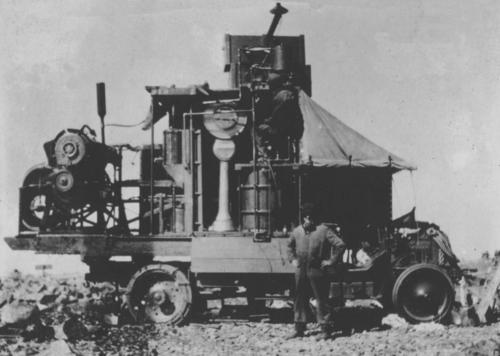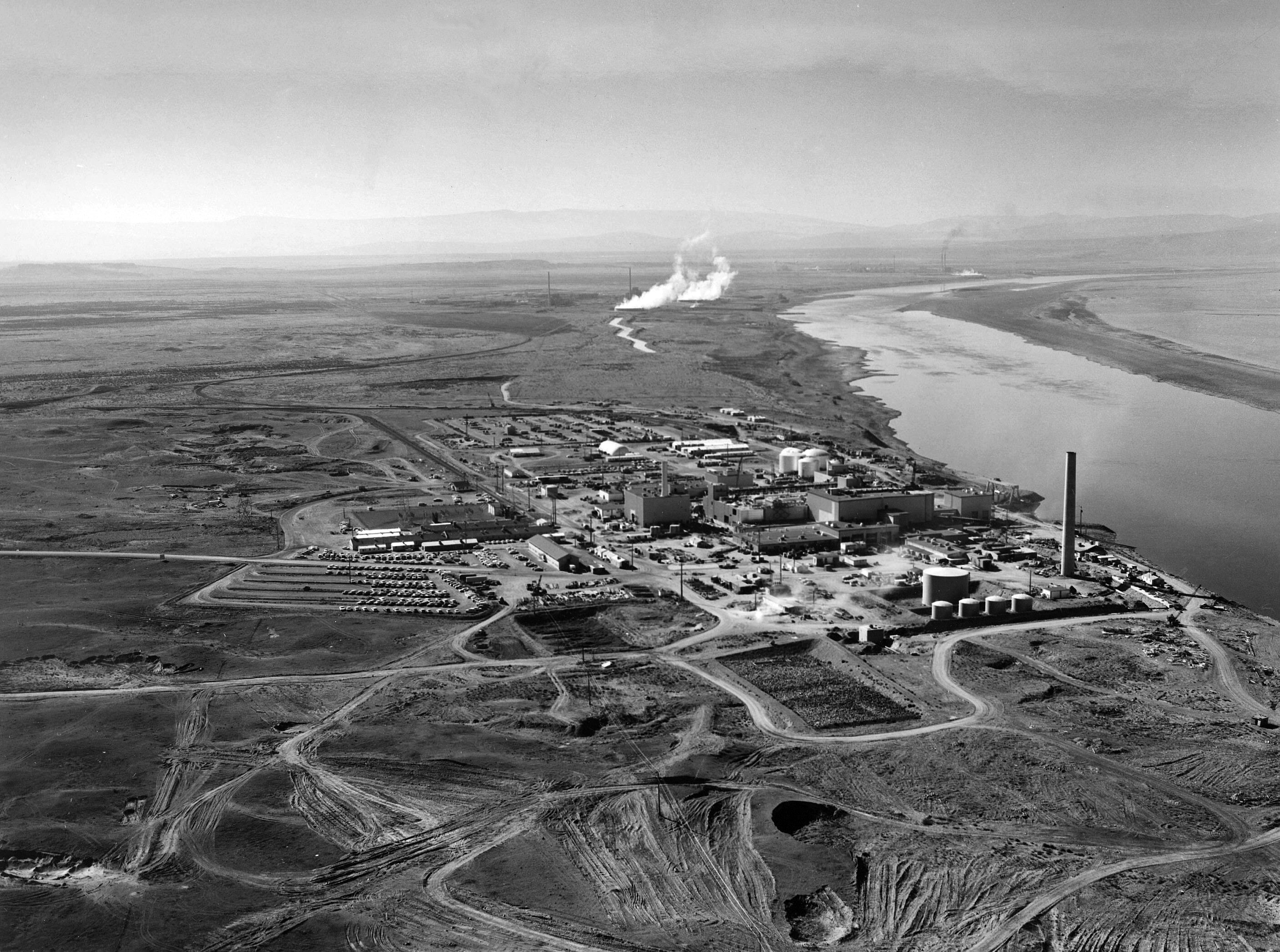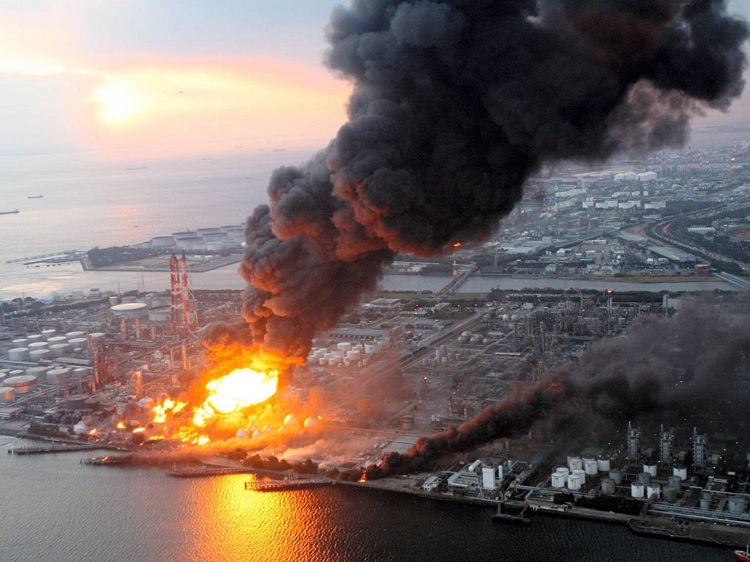As one of the largest corporations in the United States, General Electric worked in a huge number of areas, including the defense industry of the country. The company,
known as a manufacturer of light bulbs and refrigerators, equipment for power grids and wind generators, x-ray machines and MRI scanners , equips the American army with machine guns, military equipment and even took part in the creation of bombs dropped on Hiroshima and Nagasaki. At the same time, a company that tries to position itself through the production of "green" technologies, as friendly to nature, has repeatedly been found to pollute the environment, and it is trying to pay as little tax to the US budget as possible, lobbying its interests.
Today we will talk about nuclear bombs, machine guns, rivers contaminated with toxic waste, and recall the cartel arrangement that laid the foundation of the modern consumer economy - planned obsolescence, and the support of Hitler's American corporations.
 Is that a heavy robot can cope with the General Electric M134 Minigun .
Is that a heavy robot can cope with the General Electric M134 Minigun .Phoebus Cartel: scheduled obsolescence
The founder of General Electric, Thomas Edison, spent many years searching for the incandescent filament material that would allow the bulb to burn for a long time, and in 1910 produced a tungsten filament lamp after purchasing a patent from the Russian inventor
Alexander Lodygin . But the company was profitable to sell more light bulbs. In the 1920s, manufacturers of 95% of the incandescent lamps market, Osram, Philips, Tungsram, Associated Electrical Industries, ELIN, Compagnie des Lampes and General Electric, entered into a
cartel agreement of Phoebus .
In the Guinness Book of Records, a Shelby Electric carbon filament light bulb
is brought in , which has been
lit continuously since 1901, 24 hours a day. Someone in the old country house probably has light bulbs, issued in the 1940-1960-ies in the USSR. So why do ordinary incandescent bulbs burn quickly? Because the consumer economy involves frequent purchases. Cartel conspiracy Phoebus envisaged a reduction in the cost of production of lamps and the restriction of their work 1000 hours, and for exceeding this period, the producers of the collusion were threatened with a fine.
Because of the planned obsolescence, which laid the foundations of the cartel collusion of the 1920s, today we have to recycle household appliances after a few years of work, and old refrigerators can continue to work for decades.
 Centenary light at a California fire station that has been burning since 1901
Centenary light at a California fire station that has been burning since 1901Military equipment
Fully peaceful at first glance, corporations can earn on the war. It is easy to retool the production facilities for the needs of the army, for the production of shells, cartridges, rifles, parts for military equipment. "Pasta 7.62 mm" was on the other side of the ocean: General Electric created weapons since the First World War and was involved in the development of one of the first US tanks
Holt gas-electric tank .
In 1917, the Americans assembled on the basis of
the Holt tractor the only prototype of a real hybrid tank. The 4-cylinder gasoline engine of the tank transmitted torque to the dynamo machine, which generated current for two electric motors driving the tank tracks. One of the main drawbacks of the system was the problem with overheating. To eliminate it, water cooling was used. A 75-mm cannon and two 7.92-mm Browning machine guns were installed on the machine.
The maneuverability of the 23-ton car did not differ, it could not climb the mountain, so it did not go into the series. But it remained the first tank in US history.

At the beginning of the 20th century, General Electric engineer
Sanford Alexander Moss suggested using hot exhaust gas for turbine operation, suggested the possibility of using this technology for airplanes and began developing a “turbocharger” capable of increasing the air pressure in the engine cylinders and giving it more energy. In 1918, Moss compared the work of a conventional engine with an Aviation Liberty V-12 with a turbocharger at an altitude of about 4,200 meters above sea level and proved the effectiveness of its solution at high altitude, where air is rarefied, having received for General Electric a state order to assemble turbo-compressors for aircraft.
In 1921,
Le Pert’s biplane with a turbocharger installed took off to a height of 10,518 meters,
setting a world record that lasted two years, and in 1937 Howard Hughes flew from Birbank in California to New York in 1937 by plane with General turbochargers Electric.
This system is widely used in aviation. In the late 1930s, turbochargers were already standing on
Lockheed P-38 Lightning fighters , which, thanks to the muffling of exhaust by turbocharging, were very quiet for this type of aircraft, and
Boeing B-17 Flying Fortress non-killing bombers could
return to the base with one running engine out of four.
 Sanford Alexander Moss on Pikes Peak Mountain in Colorado
Sanford Alexander Moss on Pikes Peak Mountain in ColoradoIn 1930, British design engineer
Frank Whittle patented the world's first
gas turbine (turbojet) engine , and in 1936 opened Power Jets to produce and sell it. Of course, promising new products are interested in America.
In the early 1940s, General Electric received a top-secret government order to develop the first jet engine. A group of engineers was called
the Hush-Hush Boys , which reflected the secrecy of their mission. This group received a secret delivery from King George VI of the UK to several Frank Whittle engines and improved the W.1 engine. General Electric, which previously produced only turbochargers, began producing General Electric J31 engines for the first US
P-59 Airacomet jet fighter. He did not have time to take part in hostilities, but became an important stage for the American aviation industry.
 Hush-Hush Boys Engineers Group
Hush-Hush Boys Engineers Group Bell fighter Bell P-59 Airacomet
Bell fighter Bell P-59 AiracometThe famous
F-16 Falcon is in most cases equipped with a General Electric F110 engine. This and the previous model lineup aircraft first used the Pratt & Whitney engines, and then switched to GE. General Electric engines provided thrust sufficient to take off from an aircraft carrier without the use of an afterburner.

Weapons for aviation
World War II jet fighters developed much higher speeds than the first WW1 military airplanes. Accordingly, the weapons that were installed on them had to be accelerated - otherwise, the target would be impossible to shoot at high speed. To solve this problem, one of the divisions of General Electric began work on a multi-barrel gun according
to the Gatling scheme . The result of the work was to be a gun capable of making 6,000 rounds per minute, that is, 2 times the size of the classic Gatling electric machine gun.
On October 5, 1954, a prototype of the
Lockheed XF-104 Starfighter fighter with a
General Electric J79 engine , equipped
with the T171 Vulcan 20-mm
six-barreled cannon developed by the same company, flew into the air in the desert in Southern California. From 1959 to the present, this gun is produced under the name
M61 Vulcan .
 Prototype of the Lockheed XF-104 Starfighter fighter, October 5, 1954
Prototype of the Lockheed XF-104 Starfighter fighter, October 5, 1954Already in the 1940s, helicopters
began to appear in the US Army. In the 1920s, the US Army financed George Botezat, an inventor of Russian origin, who raised the first
quadcopter into the air, and in the 1940s worked with
Igor Sikorsky , who created the first commercially produced
Sikorsky R-4 helicopter in the USA. In 1944, helicopters began to be used in military operations for the evacuation of soldiers, the supply of encircled units, and surveillance.
With the development of this direction, the need for quick-fire aviation guns lighter than the M61 Vulcan. During the
Vietnam War, the American army first used the
M134 Minigun , producing between 3,000 and 6,000 rounds per minute.
 Shelling on the Vietnamese jungle from M134 Minigun
Shelling on the Vietnamese jungle from M134 Minigun Machine gun M134 Minigun
Machine gun M134 MinigunWith 24 seconds in this fragment of the 1987 Predator film, Bill Dwick shoots an alien creature from M134 Minigun. The six-barreled machine gun can be seen in the films "Terminator 2", "Expendables 3", it often stirs the imagination of the amateur video games.
In the late 1970s, General Electric began production of the XM214 Microgun, a lightweight version of the M134. The gun was not included in the series, but we have such a wonderful advertisement of the 1980s. Just like a game console ad, just a machine gun.
 XM214 Microgun. A source
XM214 Microgun. A sourceNuclear weapon
At the end of 1938, German physicists
Otto Gan ,
Fritz Strassmann , and
Lisa Meitner , who because of Jewish origin moved to Stockholm, split the nucleus of the uranium atom for the first time as a result of joint work, discovering that during the reaction energy is released 200 million times more than the energy of the neutron that caused it.
The world faced a threat: Germany could be the first to get a weapon that, in terms of deadliness, was the worst thing that was invented before, including all types of chemical weapons. The United States and the USSR joined in the study of the discovered properties to create a nuclear bomb. The Americans built an entire city for this purpose, called the
Manhattan Project nuclear weapons program.
129 thousand people, among whom were Niels Bohr, John von Neumann, Robert Oppenheimer, Enrico Fermi and many other outstanding minds of his time participated in the project. A lot of people-calculators were involved, and in 1943 the
IBM 601 tabulators were connected to the work, which allowed for three weeks to perform the amount of calculations that people would have spent six months on. July 16, 1945 at the site in New Mexico blew plutonium bomb "little things", a version of which in the form of a bombs "Fat Man" the equivalent of 21 kilotons of TNT
dropped on Nagasaki August 9, 1945. On August 6, the
uranium bomb “Kid” was equivalent to 13 kilotons of TNT on Hiroshima. The targets were not chosen by chance - Hiroshima was an important supply base for the Japanese army, while ships, torpedoes and military equipment were produced in Nagasaki.
Americans for the first time in the world used nuclear weapons
against the population . The number of deaths according to various estimates ranged from 150,000 to 246,000 people.
One of the companies that were involved in the "Manhattan Project" was General Electric. In particular, General Electric helped develop an improved welding technology. Since 1943, the corporation has been included in the production process for the creation of nuclear bombs.
 Hiroshima after the attack
Hiroshima after the attackFrom 1981 to 1989, the president of the United States was
Ronald Reagan . He did not spare the money for defense - he spent $ 282 billion on this item in the budget, overtaking his predecessor,
Jimmy Carter, with his $ 160 billion almost doubled.
Prior to his political career as governor and president, Ronald Reagan built a career as an
actor and TV host . For a time, he was the face of General Electric, and was probably warm with an innovative corporation that included hundreds of companies in various fields. In 1984, General Electric produced more nuclear bombs than any other company in the world, replenishing the US nuclear stockpile in an arms race.
Ronald Reagan advertises General ElectricIn the 1990s, activists of
Corporate Accountability International launched a large-scale campaign against General Electric — in the United States, Canada, and even in Europe, they boycotted light bulbs and household appliances and called for a refusal to buy GE medical equipment. Stores began selling goods from other companies, abandoning General Electric. Doctors supported the boycott. In 1991, the film "Deadly Deception: General Electric, Nuclear Weapons and the Environment" was released, which in 1992
received the Oscar for best short documentary. Because of the boycott, GE lost 19 million dollars on medical equipment, and more than 100 million because of the refusal to buy other goods from it. As a result, in 1993, General Electric President
Jack Welch announced the company's refusal to manufacture nuclear weapons.
 Activist against corporate earnings on nuclear weapons
Activist against corporate earnings on nuclear weaponsConnection with Nazi Germany
The “chief accountant” of Nazi Germany,
Jalmar Schacht , one of the defendants of the
Nuremberg Trials , replied to the American prosecutor: “If you want to indict the industrialists who helped rearm Germany, then you must indict yourself. You will have to indict the Americans. The Opel automobile plant, for example, did not produce anything except military products. Owned this plant is your
"General Motors" .
After the First World War, the
Versailles Peace Treaty of 1919 was signed, under which Germany had to pay 269 billion gold marks - 100 thousand tons of gold. Weakened by defeat, Germany found itself in extremely difficult conditions. New ways of attracting money were needed. This opportunity was presented to the country by American friends thanks to
Charles Dawes , who was one of the experts who developed
a reparation payment plan that was appropriate for the country's economic opportunities. In addition to changing the amounts and terms of payment, the plan provided for loans from the United States. For example, in the first year of payments under the new plan - 1924 - Germany paid 1 billion gold marks, of which 800 million was received from American banks and corporations.
The Dawes Plan allowed Germany to restore its military and industrial potential, which it could use against the enemy of the USA - the USSR. America and a number of other countries
intervened in the civil war in Russia , sending their troops to the country — in particular, 15,000 soldiers went to Murmansk and Arkhangelsk in 1918-1920. The Entente countries did not recognize the USSR in the 1930s.
The committee that developed the Dawes Plan included General Electric President
Owen D. Jung . It was assumed that Germany will sell the goods produced in the USSR, and give the resulting income as reparations. So the Soviet Union had to remain an agrarian country, a raw materials appendage of Germany. Joseph Stalin was sure of the failure of such an idea, as he
said at the XIV Congress of the CPSU (B.): “We don’t want to turn into an agrarian country for any other country, including Germany. We ourselves will produce machines and other means of production. Therefore, to rely on the fact that we will agree to turn our Homeland into an agrarian country for Germany is to count without a master. In this part, the Dawes Plan is on clay feet. ”
During the war, General Electric had its own interests in the German AEG, which was engaged in the production of weapons, including bombers, both in the First and in World War II. The German company
AEG , or Allgemeine Elektrizitäts-Gesellschaft, was founded after Emil Rathenau bought in 1883 patents for Thomas Edison’s inventions. In 1929, General Electric bought a 27.5% stake in AEG, and five people from General Electric joined the supervisory board of the German company. In 1933, AEG was one of the companies that sponsored Hitler's rise to power. During World War II, the company produced night vision devices that helped German troops use artillery and tanks at night.
 Document No. 391-395, Nuremberg Process: an instruction from General Electric in Germany to transfer funds to the Mine and Hess Foundation, from which Adolf Hitler's electoral company was sponsored in March 1933
Document No. 391-395, Nuremberg Process: an instruction from General Electric in Germany to transfer funds to the Mine and Hess Foundation, from which Adolf Hitler's electoral company was sponsored in March 1933Environmental pollution
As part of the "Manhattan Project" in 1943, the
Hanford complex was built, where the world's first reactor for the industrial production of plutonium was commissioned. The costs of the project for the production of nuclear weapons were high, so the government at the same time asked for other ways to use the new source of energy. In the mid-1950s, thanks to this, one of the first American nuclear submarines
Seawolf was launched, but the “peaceful atom” became a much more important event: in 1948, electric appliances were powered by
the X-10 graphite reactor for the first time.
Since 1946, the Hanford complex has been transferred to General Electric, and over the next 40 years, two thirds of the total plutonium produced in the United States was produced here - 57 tons. As a result, about 1 trillion tons of groundwater over an area of more than 80 square miles
was contaminated with metals and radionuclides. According to the data for 2008, 170 tanks left over 200 thousand cubic meters of liquid radioactive waste, as well as 750 thousand cubic meters of solid waste. For comparison: during the
“Kyshtym catastrophe”, due to the explosion of a capacity of 300 cubic meters filled with 80 cubic meters of highly reactive nuclear waste, 23 villages were resettled, and buildings, property and livestock were destroyed.
On May 9, 2017, the American media
announced the alarm : due to soil subsidence over a railway tunnel with wagons loaded with waste from plutonium production. Previously, leaks from storage tanks were
reported in 2013. Today it is one of the most polluted places on the planet.
 Hanford complex. US Department of Energy
Hanford complex. US Department of EnergyThe waste that the Hanford complex stores is especially dangerous because of its location on the banks
of the Columbia River , along which there are many cities. But there is another type of pollution to which General Electric participates: in drinking water in the USA,
polychlorinated biphenyls can be found that pose a danger to human life and health. In 1999, the company
paid a fine of 250 million for pollution of the
Husatonic River . Previously, the same
problems were on the Hudson River, in the 1970s people were forbidden to fish on it because of too much pollution. The fish itself has
developed immunity to toxic waste.
 Hudson River. Juliancolton
Hudson River. JuliancoltonIn 2011, at the nuclear power plant
Fukushima-1 in Japan, an accident occurred due to an earthquake and tsunami. The power supply required for cooling the reactors failed, causing the core (the space in which the controlled reaction occurs) to melt. In 2017, one of the reactors was reported to have
leaked . The elimination of the disaster is still ongoing.
All reactors of the nuclear power plant Fukushima-1 were designed by General Electric. In 2017, residents, businessmen and doctors of Fukushima Prefecture
filed a lawsuit at a federal court in Boston, accusing the company of design errors. They argued that already during the design of the station in the 1970s, it was known that the reactors would not withstand earthquakes and tsunamis.
In 2011, there was news in the media that, 35 years before the accident, engineer Dale G. Bridenbaugh
retired from General Electric because he could not prove to the management that the Mark 1 shell, which was planned to be used in reactors, insufficiently reliable and will not withstand pressure in the event of a cooling system failure. But the company took a risk, and thirty years after the launch of the nuclear power plant, this turned out to be a disaster.

Total
It is difficult to blame any company in the production of weapons necessary to equip the army during the war. Tractor plants produced tanks, other companies - rifles and machine guns. But sometimes this work is done not to protect the country, but on an ongoing basis for the sake of earning.
Today, General Electric continues to collaborate with US forces. In just an incomplete decade — from 2007 to 2016 — General Electric
received contracts worth $ 28 billion, and this excluding contracts worth less than $ 6.5 million. These are mainly
engines for aircraft and ships, flight control systems, including autopilots, as well as electric generators, machine guns, and individual components for weapons. The company has the right to earn to pay taxes.
For any company it is logical to reduce costs, including trying to get tax breaks and refunds. In 2010, General Electric reported a profit of $ 14.2 billion, of which 5.1 billion was earned in the United States. But the company received tax breaks of $ 3.2 billion. For 2004-2009, according to the
New York Times . The company received 26 billion in profits in the United States alone, while at the same time it saved 4.1 billion thanks to the country's Federal Tax Service.
Thanks to skillful manipulations with legislation and lobbying, American companies have reduced their contribution to the country's budget for half a century: if in the 1950s 30% of federal income were company taxes, by 2009 this figure had dropped to 6.6%.
In 1919, Ford wanted to give an excess of profit in payments to workers and for hiring new employees. But the Ford Motor Company was sued by the Dodge brothers, owners of the eponymous car company and FMC investors. They argued that it was the corporation’s first duty to make profits for shareholders. This precedent formed the basis of US corporate law.Over the 125 years of its existence, General Electric has grown from the brainchild of Thomas Edison into a real multinational colossus. She has not ceased to improve the life of all mankind by inventing various devices and making them cheaper. But do not forget that the goal of any corporation is to make a profit for its shareholders, and not strict adherence to moral standards. GE is no exception.